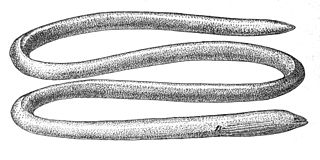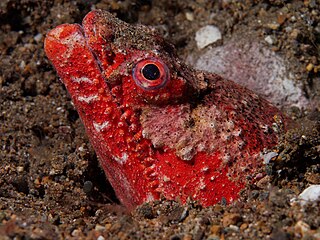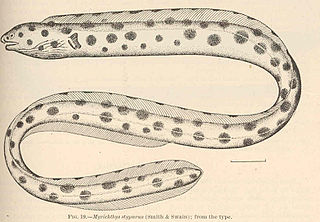Phaenomonas is a genus of eels in the snake eel family Ophichthidae.

Moringua edwardsi, the common spaghetti eel, is an eel in the family Moringuidae. It was described by David Starr Jordan and Charles Harvey Bollman in 1889, originally under the genus Stilbiscus. It is a subtropical, marine eel known from the western Atlantic Ocean, including Antigua and Barbuda, Aruba, the Bahamas, Barbados, Belize, Bermuda, Cuba, Dominica, Grenada, Guadeloupe, Honduras, Jamaica, Martinique, Mexico, Montserrat, Nicaragua, Puerto Rico, Saint Kitts and Nevis, Saint Lucia, Saint Vincent and the Grenadines, Trinidad and Tobago, Florida, Venezuela, the Virgin Islands, British, and the Virgin Islands of the United States. Males can reach a maximum total length of 15 cm, while females can reach a maximum of 50 cm. The eels feed primarily off of burrowing invertebrates.
The rusty spaghetti eel, also known as the rusty worm eel, the slender worm eel, or the intermediate thrush-eel is an eel in the family Moringuidae. It was described by Richard Bliss Jr. in 1883. It is a tropical, marine eel which is known from the Indo-Pacific region, including East Africa, Easter Island, the Ryukyu Islands, Australia, and Micronesia. It leads a benthic lifestyle, burrowing into sandy regions in reefs at a depth range of 1–40 m. Males can reach a maximum total length of 140 cm.

The Java spaghetti eel, also known as the Java thrush-eel, Java worm eel, and the black-tailed thrush eel is an eel in the family Moringuidae. It was described by Johann Jakob Kaup in 1856, originally under the genus Aphthalmichthys. It is a tropical, marine eel which is known from the Indo-Pacific, including East Africa, the Tuamoto Islands, the Ryukyu Islands, and Micronesia. It is a burrowing species which inhabits reefs at a depth range of 2–15 m. Males can reach a maximum total length of 120 cm.
The whitespotted garden eel, also known as the Indian spaghetti eel, is an eel in the family Congridae. It was described by Wolfgang Klausewitz and Irenäus Eibl-Eibesfeldt in 1959. It is a marine, tropical eel which is known from the Indo-Western Pacific, including Maldives, the Solomon Islands, the Philippines, the Cocos Islands, Comoros, India, Indonesia, and Papua New Guinea. It dwells at a depth range of 25 to 48 metres, and lives in non-migratory colonies that form burrows on sandy slopes, usually near coral reefs. Males can reach a maximum total length of 70 centimetres (28 in).
The Galapagos garden eel is an eel in the family Congridae. It was described by Irenäus Eibl-Eibesfeldt and Friedmann Köster in 1983, originally under the genus Taenioconger. It is a marine, tropical eel which is known from the eastern central and southeastern Pacific Ocean, including Colombia, Costa Rica, the Galapagos Islands in Ecuador, and Panama. It dwells at a depth of 10 to 30 m, and lives in large, nonmigratory colonies in clean, sandy substrates. Males can reach a maximum total length of 70 cm.
The Johnston snake eel, also known as the peppered worm eel in Micronesia and Hawaii is an eel in the family Ophichthidae. It was described by Leonard Peter Schultz and Loren Paul Woods in 1949. It is a marine, tropical eel, which is known from the Indo-Pacific region, including the Chagos Islands, Hawaii, the Marquesan Islands, the Society Islands, Australia, and New Caledonia. It dwells at a depth range of 2–23 m, and inhabits sand sediments in coral reefs. It can reach a maximum total length of 35 cm.
The Fringe-lipped worm-eel is an eel in the family Ophichthidae. It was described by Henry Weed Fowler in 1934. It is a marine, tropical eel which is known from the western central Pacific Ocean, including Taratara Island, Samar Island, the Philippines, the Marshall Islands, Micronesia and Solomon Island. It dwells at a maximum depth of 48 metres (157 ft), and inhabits benthic sand sediments in coral reefs. Males can reach a maximum total length of 11.5 centimetres (4.5 in).
Scolecenchelys chilensis is an eel in the family Ophichthidae. It was described by John E. McCosker in 1970, originally under the genus Muraenichthys. It is a marine, subtropical eel which is known from Desventuradas Island and Juan Fernández Island, in the southeastern Pacific Ocean. It inhabits sand and debris found in between crevices and rocks. Males can reach a maximum standard length of 28.4 centimetres (11.2 in).
The Indo-Pacific slender worm-eel is an eel in the family Ophichthidae. It was described by Pieter Bleeker in 1857. It is a marine, tropical eel which is known from the Indo-Pacific, including the Red Sea, East Africa, the Line Islands, the Society Islands, Johnston Island, Japan, Rapa Iti, Micronesia, and the southern Great Barrier Reef. It forms burrows in inshore sediments of loose gravel and sand. Males can reach a maximum total length of 38 centimetres (15 in).

The reptilian snake eel, also known as Henshaw's snake eel, the Hawaiian crocodile eel or the crocodile snake eel, is an eel in the family Ophichthidae. It was described by David Starr Jordan and John Otterbein Snyder in 1904.

Callechelys lutea, the freckled snake eel or yellow-spotted snake eel, is an eel in the family Ophichthidae. It was described by John Otterbein Snyder in 1904.

The magnificent snake eel, also known as the Hawaiian spotted snake eel, is an eel in the family Ophichthidae. It was described by Charles Conrad Abbott in 1860, originally under the genus Pisodonophis. It is a marine, tropical eel which is known from the eastern central Pacific Ocean, including the Hawaiian Islands, the Leeward Islands, Johnston Island, and Midway Atoll. It dwells at a depth range of 1 to 262 metres, and inhabits crevices, sand and rocks. Males can reach a maximum total length of 78 centimetres (31 in).

The goldspotted eel, also known as the goldspotted snake eel or the dark-spotted snake eel, is an eel in the family Ophichthidae. It was described by Charles Alexandre Lesueur in 1825, originally under the genus Muraenophis. It is a marine, tropical eel which is known from the western and eastern Atlantic Ocean, including Bermuda, southern Florida, USA; the Bahamas, Santa Catarina, and Brazil. It dwells at a maximum depth of 15 metres (49 ft), and inhabits rocky and coral reefs. Males can reach a maximum total length of 110 centimetres (3.6 ft).

The dark-shouldered snake eel is an eel in the family Ophichthidae. It was described by Pieter Bleeker in 1864. It is a tropical, marine eel which is known from the Pacific Ocean, including the East Indies, the Society Islands, the Mariana Islands, Queensland, the Marshall Islands, Micronesia, Japan, and India. It dwells at a depth range of 2–15 metres, and inhabits reefs. It forms burrows in mud and sand, and forages during the night. Males can reach a maximum total length of 115 centimetres.

The Pacific snake eel is an eel in the family Ophichthidae. It was described by Johann Jakob Kaup in 1856, originally under the genus Muraenopsis. It is a marine, subtropical eel which is known from the eastern central and southeastern Pacific Ocean, including California, USA, Peru, the Gulf of California, Mexico, the Galapagos Islands, Colombia, Ecuador, Costa Rica, El Salvador, Honduras, Guatemala, Nicaragua, and Panama. It dwells at a maximum depth of 155 metres (509 ft), and forms burrows in mud and sand sediments. Males can reach a maximum total length of 115 centimetres (45 in), but more commonly reach a TL of 80 centimetres (31 in).
The Pouch snake eel is an eel in the family Ophichthidae. It was described by George S. Myers and Charles Barkley Wade in 1941, originally under the genus Letharchus. It is a marine, tropical eel which is known from the eastern central and southeastern Pacific Ocean, including the Galapagos Islands, the Revillagigedo Islands, and the Cocos Islands. It is known to dwell at a maximum depth of 10 metres (33 ft), and inhabits sand sediments. Males can reach a maximum total length of 64.3 centimetres (25.3 in).
Phaenomonas longissima, also known as the short-maned sand eel in St. Helena, is an eel in the family Ophichthidae. It was described by Jean Cadenat and Émile Marchal in 1963, originally under the genus Callechelys. It is a marine, tropical eel which is known from the Atlantic Ocean, including Ascension Island, St. Helena, Brazil, Senegal, Ghana, and Cape Verde. It dwells at a depth range of 25 to 35 metres, and forms burrows in sand and mud sediments on the continental shelf. Males can reach a maximum total length of 50 centimetres (20 in).
The elastic eel is an eel in the family Ophichthidae. It was described by George S. Myers and Charles Barkley Wade in 1941. It is a tropical, marine eel which is known from the eastern central and southeastern Pacific Ocean, including Colombia, Ecuador, Costa Rica, and Mexico. It dwells at a depth range of 1–35 metres, inhabiting sandy bottoms. Males can reach a maximum total length of 53.5 centimetres.

The Kaup's arrowtooth eel is an eel in the family Synaphobranchidae. It was described by James Yate Johnson in 1862. It is a marine, deep water-dwelling eel which is known from the Indo-Western Pacific and eastern and western Atlantic Ocean, including the Faroe Islands, Iceland, Cape Verde, the Western Sahara, Nigeria, Namibia, South Africa, Greenland, France, Saint Pierre and Miquelon, the United Kingdom, Ireland, the Philippines, Portugal, Spain, the Bahamas, Brazil, Canada, Cuba, Japan, Australia, Mauritania, Morocco, and Hawaii. It dwells at a depth range of 120 to 4,800 metres, most often between 400 and 2,200 metres, and inhabits the upper abyssal zone on the continental slope. It is intolerant of the temperatures of higher waters. Males can reach a maximum total length of 100 centimetres (39 in).








